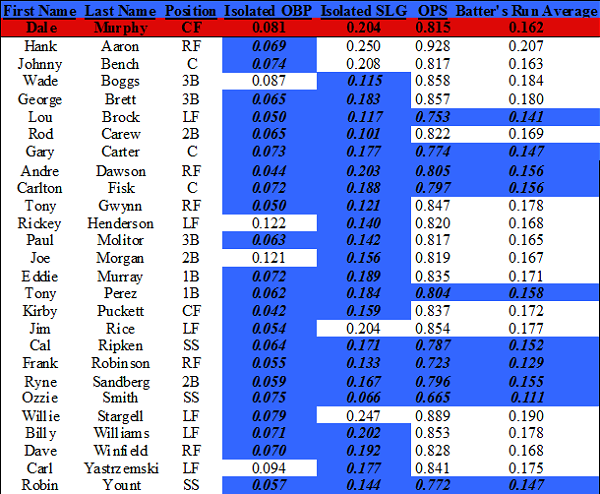Murphy’s Law: 2 MVP Trophies, 4 Silver Slugger Awards, 5 Gold Gloves, and 7 All-Star Games May Not Get You Into the Hall of Fame
December 27, 2010 by Curt Hitchens · 5 Comments
Introduction
The purpose of this study is to compare Dale Murphy to other Hall of Fame position players from the same era (1976-1993). His .265 batting average, 2,111 hits, and 398 home runs seem to be on par with other Hall of Fame hitters.
This study will identify how many Hall of Famers performed below Dale Murphy in the following areas:
- Batting Average
- On-Base Percentage
- Slugging Percentage
- Isolated On-Base Percentage
- Isolated Slugging Percentage
- On-Base Plus Slugging Percentage
- Batter’s Run Average
Murphy’s run prevention skills will also be examined. The results of this study will be used to determine whether he is comparable to other Hall of Famers from his era.
Methodology
Thirty Hall of Fame position players were examined in this study. Pitchers, Negro League Players, and other Hall of Famers were not included in the sample. The goal was to identify players that performed below Dale Murphy in the areas of batting average, on-base percentage, slugging percentage, isolated on-base percentage, isolated slugging percentage, on-base plus slugging percentage, and batter’s run average. These statistics were chosen because of their strong correlation with run production and winning.
Results
Batting Average, On-Base Percentage, and Slugging Percentage:
Approximately 60% of the sample performed below Dale Murphy in one or more area. As a group, these players produced a .287 batting average, .361 on-base percentage, and .464 slugging percentage. Murphy performed below the sample in the areas of batting average and on-base percentage.
The players that performed below Dale Murphy can be divided into three groups.
- Catchers (17% of the Sample)
- Outfielders (33% of the Sample)
- Infielders (50% of the Sample)
Portion of Sample Performing Below Murphy: One or More Area
Isolated On-Base Percentage, Isolated Slugging Percentage, On-Base Plus Slugging Percentage, and Batter’s Run Average:
Approximately 87% of the sample performed below Dale Murphy in one or more area. As a group, these players produced a .074 isolated on-base percentage, .177 isolated slugging percentage, .826 on-base plus slugging percentage, and .168 batter’s run average. Murphy performed below the sample in the areas of on-base plus slugging percentage and batter’s run average.
The players that performed below Dale Murphy can be divided into three groups.
- Catchers (12% of the Sample)
- Infielders (42% of the Sample)
- Outfielders (46% of the Sample)
Portion of Sample Performing Below Murphy: One or More Area
Run Prevention – Dale Murphy (1976-1993):
Conclusions
In the 2010 Hall of Fame election, only 11.7% of the Baseball Writers Association of American voted for Dale Murphy. They may want to reconsider his offensive and defensive contributions before casting their votes in future elections.
According to the results of this study, Dale Murphy was a complete player. He excelled at driving in and preventing runs. Murphy also spent most of his career in center field, one of the most demanding defensive positions.
The tables below contain statistics for Dale Murphy and Johnny Bench. These players appear to be almost identical from an offensive standpoint.






What’s missing is a control for the era he played in. The 1980s were higher scoring/hitting than than the 1970s for example, which when accounted for makes Bench’s #s look better and Murphy’s a little worse. I think Murphy’s also hurt somewhat by his limited period of consistency where he was a dominant player from 1980-87, but suffered from supbar years before and for several seasons after. Perhaps its the Murphy of 1989-1993 that’s dragging him down – just too long a decline.
This analysis is devoid of context.
o The offensive levels of each player’s era must be considered.o The offensive norms for each position must be considered.
o Only half of Murphy’s career innings played were as a CF so to completely lump him in with other center fielders is not fair.
This is fanboyism poorly disguised as objective analysis.
I am a forty-year Braves fan; Dale and my hero-worship days had coincidental peaks. That said, I’m firmly on the fence as to whether his career is Hall-worthy.
The article and the two responses all contain valid points; I propose that for the sake of the argument, we set aside stats and accept Awards as a valid barometer for career comparisons. That would seemingly lead to this question:
How many HoF-eligible players with 2 MVP Trophies, 4 Silver Slugger Awards, 5 Gold Gloves, and 7 All-Star Games are there that have NOT been elected?
Thanks for the constructive criticism! I compared Murphy to all HOFers from his era. Finding the offensive norms at each position would have been helpful. Promoting Murphy was not my goal . I simply wanted to show that his stats matched up favorably with current HOFers from his era. Most people don’t seem to value his run prevention skills.
Dale Murphy was among the top three or four baseball players in all of the MLB for about 5 to 7 years. And, it could be argued he was the best for a couple. The question is does the hall want to reward many years of pretty good or a few years of great. Also, can anyone doubt that, unlike others, Dale Murphy would not sacrifice character (no stimulants or PEDs) to maintain skills that deteriorate with age?